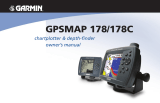
GPSMAP 176/176C Owner’s Manual 1
INTRODUCTION > TABLE OF CONTENTS
Table of Contents
Introduction ...........................................................................i
About This Manual ................................................................... i
Care Information ...................................................................... ii
Getting Started .....................................................................3
Unit Basics ............................................................................... 3
Interface Keys .......................................................................... 6
Basic Operation ...................................................................7
Initializing the GPS Receiver .................................................. 7
Using the Map Pointer ............................................................ 9
Selecting Map Zoom Ranges ............................................... 11
Creating and Using Waypoints ............................................ 12
Marking Your Present Location .................................................... 12
Creating Waypoints Graphically ................................................... 13
Entering Coordinates .................................................................... 14
Projecting Waypoints .................................................................... 15
Waypoint Menu Options ............................................................... 16
Reviewing and Editing Waypoints ............................................... 17
Waypoint Lists .............................................................................. 19
User Waypoint List ................................................................. 20
User Waypoints List Options .................................................. 21
Proximity Waypoint List ......................................................... 22
Recent Waypoint List .............................................................. 23
Going to a Destination .......................................................... 24
Selecting a Go To Graphically ...................................................... 25
TracBack Navigation (Navigating a Track) .................................. 26
MOB ............................................................................................. 28
Creating a Route .................................................................... 29
Following a Route ........................................................................ 31
Route List Page ............................................................................. 32
Route Review Page ....................................................................... 33
Route Review Menu Options ....................................................... 35
Active Route Page ........................................................................ 39
Find ......................................................................................... 39
Main Pages .........................................................................41
Map Page ................................................................................ 41
Compass Page ....................................................................... 45
Highway Page ........................................................................ 46
Active Route Page ................................................................. 48
Numbers Page ....................................................................... 48
Main Menu Page ................................................................49
GPS Tab .................................................................................. 50
Trip Tab ................................................................................... 54
Route Tab ............................................................................... 54
Points Tab .............................................................................. 54
Track Tab ................................................................................ 55
Alarm Tab ............................................................................... 57




















